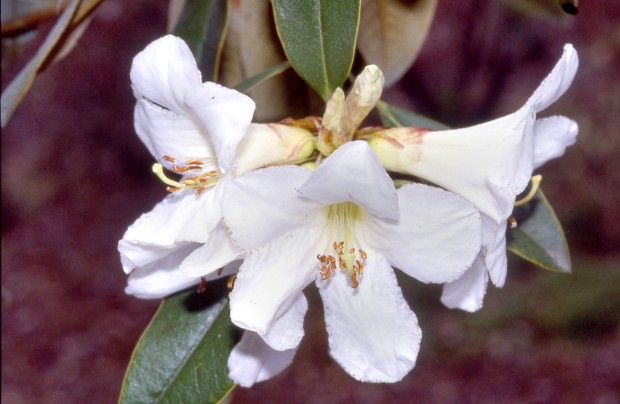
Subsection Maddenia is a large and widespread group of approximately forty lepidote (scale-bearing) species. Members of this diverse group are found terrestrially or as epiphytes from the eastern Himalaya (Nepal) in the west to southeastern China and adjacent regions of Vietnam, Laos, and Thailand in the east. With a few notable exceptions, species in this subsection are tender to semi-hardy in most of the rhododendron growing areas of the world. They typically have large, often highly fragrant flowers and a straggly or open growth habit. Many have beautiful smooth and exfoliating bark and/or colorful and interesting foliage, and many forms flower quite late in the season, well past the rush of spring.
Rhododendron maddenii is the type species for this subsection. In other words, it is the species from which the subsection was originally described. As treated in Dr. Cullen’s 1980 revision of the subsection, R. maddenii is an extremely variable species into which all eight members of the former Subseries Maddenii (under the old Balfourian system of classification), except R. excellens, have been lumped. It is distinguished from the other members of subsection Maddenia primarily by its greater number of stamens and ovary chambers. Taken as a whole, these eight “former” species occur from the Sikkim Himalaya in the west through China and Burma to Vietnam in the east. As one would expect from a group of plants with such an extensive range, there is a tremendous variation in the morphological features that are typically used to separate closely related taxa, including such things as flower size, number of stamens, and scale density. Unfortunately, most of this variability and intergradation of distinguishing characteristics cannot be correlated sufficiently enough with important factors such as natural range to define clear-cut taxa. This is the botanical justification for the merging of this complex and closely related group of “species” into the single species maddenii.
Within this classification scheme, R. maddenii is divided into subspecies maddenii from the western end of the range, and subspecies crassum, generally found in the eastern half of the range. Included within ssp. maddenii are the former species calophyllum, brachysiphon, maddenii, and polyandrum. These all have a truncated apex on the fruiting capsules. The ssp. crassum includes the former species crassum, manipurense, chapaense, and odoriferum. Members of this group have rounded capsule apices and generally wider leaves.
Rhododendron maddenii is one of the “original” rhododendrons first introduced from the Himalaya by J.D. Hooker in the mid 1800s (1849). It was named for Lt.-Col. E. Madden, a member of the Bengal Civil Service. The other “species” now lumped under R. maddenii were subsequently introduced and named from various widespread locations:R. brachysiphon – Cooper (1915) Bhutan; R. calophyllum – Booth (1853) Bhutan; R. chapaense – Dop (1930) Indo-China; R. crassum – Delavay (1885) W. Yunnan (introduced by Forrest in 1906); R. manipurense – Watt (1882) Naga Hills, Assam; R. odoriferum – described by Hutchinson in 1927 from a cultivated plant raised from seed collected by Bailey in S. Xizang, China; and R. polyandrum – Cooper (1914) Bhutan (introduced by him the following year).
R. maddenii ssp. maddenii is found in the eastern end of the Himalaya Mountains, from Sikkim and Bhutan to Arunachal Pradesh. It occurs at elevations of 5,000 to 10,000 ft. in a wide range of habitats. Subspecies crassum is found from the Naga Hills in NE India into SE Xizang and Yunnan, China, and south into Vietnam. It occurs at elevations of 5,000 to 12,000 ft. and also in many different habitats. I have observed this common species in the wild on many occasions, from Sikkim at the far western end of its range to Arunachal Pradesh (where the two subspecies seem to merge into each other) and the Naga Hills of NE India to Yunnan, China, where ssp. crassum is found on virtually every mountain. These plants were found growing in a wide range of habitats, from deep forests where they formed small, single-trunked trees up to 25 feet or more in height to open slopes, cliffs, and road-cuts.
Typically, most forms of this species are vigorous-growing large shrubs or small trees, often attaining up to 30 ft. in the wild. The leaves are evergreen and extremely variable in shape and size but generally between four and eight inches in length and one to three inches wide. They are densely covered with scales beneath. The tubular-funnel shaped flowers are also more or less covered with scales on the outer surface. These highly fragrant flowers appear over a long season from mid-spring into mid-summer and can be quite large, sometimes five inches long and up to five inches across. They are generally white, sometimes pink, and rarely yellow. They typically have a pink or rose flush, and/or a pink to purple, green, or yellow base.
With such a wide altitudinal and geographical range it is not surprising that there is a great deal of variability in the hardiness of different forms that have been introduced into cultivation. Some forms are only suitable for the cool greenhouse or protected sites while others have proven to be hardy when planted outdoors in milder climates such as along the west coast of Great Britain, New Zealand, and in certain mild areas along the western coast of North America. Many of these forms are wood hardy to at least 15°F and a few will survive 10°F or even lower. Unfortunately, the flower buds are usually more tender than the plant itself and in some locations the flower buds may be frozen in any given year. One of the hardiest forms that we have grown here at the RSBG is R. maddenii ssp. crassum (formerly manipurense) RSF#1966/633 from Leonardslee which was planted in the old Upper Study Garden under an overstory canopy of conifers. This plant eventually attained a very respectable size of six feet high and eight feet across and survived a low of 7°F (with some tissue damage) in 1989 before succumbing to a killing 4°F the following year.
Our more recent efforts to determine the relative hardiness of our R. maddenii collection have resulted in many fine large plants growing without protection in the garden and producing masses of flowers in most years. Eventually, we know that a hard winter or early hard freeze will provide the killing or damaging temperatures necessary for such an evaluation. In the intervening years, we continue to enjoy the robust growth, deep green glossy foliage, and annual display of showy fragrant flowers. In addition, for those regions with little or no frost and warmer growing seasons, this species offers a wide selection of forms and colors where other rhododendrons fail due to heat stress. Due to its primarily terrestrial nature in the wild, this species, in its myriad of forms, is less difficult to please in the garden than many of its more epiphytic cousins. In our climate, established plants are relatively tolerant of drought and quickly form large robust specimens, especially in full sun. A light amount of afternoon shade is recommended to avoid foliage scorch during the hottest part of the summer however. Their vigorous and leggy growth should be taken into account when considering container cultivation or smaller areas such as courtyards. Frequent pinching and plenty of exposure to the sun will help to keep the plants compact and manageable.
This species, in its myriad of forms, has won many awards for its outstanding floral displays. The first of these was an Award of Merit (AM) in 1924 to a clone with white flowers (as crassum). Other award-winning clones include: an AM in 1933, flowers white with a yellow throat (as polyandrum); AM in 1938, flowers white with a green flush inside the tube (as maddenii); AM in 1938, flowers rose-pink (as polyandrum); and an AM in 1978 to a clone ‘Ascreavie’ from L&S#1141, flowers white flushed reddish purple (as maddenii). R. maddenii has been used extensively in hybridizing schemes, producing such well-known grexes as ‘Royal Flush,’ ‘Lady Chamberlain,’ and ‘Lady Roseberry,’ among others.
ACCESSIONS IN THE COLLECTION OF THE RSF:
maddenii ssp. crassum
1964/066 Flowers white flushed yellow in the throat.
1965/364 (odoriferum) Brodick.
1966/633 (manipurense) Leonardslee. Flowers white flushed yellow in the throat.
1969/095 Windsor. Pure white flowers with a long narrow tube and a deep green throat in early July.
1970/183 Lamellen.
1996/027 (chapaense) KR#3116 From seed collected wild in N Vietnam, white with deep yellow throat.
1996/048 (chapaense) KR#2978 As with 1996/027.
1998/697 (odoriferum) Gerdemann. “Hardy form”
2002/109 Arduaine.
2002/084 (manipurense) Arduaine.
Also – Numerous newer accessions from the Cang Shan in Yunnan that have yet to be evaluated.
maddenii ssp. maddenii
1964/115 (polyandrum) Logan. Flowers white flushed yellow and pink.
1965/360 Brodick. Flowers pale pink with a deep yellow throat.
1977/701 (polyandrum) Brodick. Creamy white flowers flushed pink on the tube with a dark yellow throat in mid-spring.
1978/109 (brachysiphon) RBG Edinburgh:Gwen Bell.
1979/014 (from seed collected in Sikkim) Flowers white flushed pink.
1980/130 (brachysiphon) Trengwainton.
1984/054 (polyandrum) KW#:Brodick. Flowers smallish but pink.
1994/001 (“Jack Evans form”) Enjoy Rhododendrons. From 1974 Sikkim seed. Masses of large white flowers with a yellow throat. An outstanding form.
1994/004 (“Scott form”) Enjoy Rhododendrons.
2001 (five accessions) SEH#599 From my collection of seed in Sikkim. These have yet to be evaluated.
REFERENCES CONSULTED:
Cox, Peter A. and Kenneth N. E. Cox. 1997. The Encyclopedia of Rhododendron Species. Perth, Scotland: Glendoick Press.
Cullen, J. 1980. A Revision of Rhododendron I. Notes from the Royal Botanic Garden Edinburgh. Vol. 39(1).
Davidian, H. H. 1982. The Rhododendron Species. Vol. I. Portland, OR: Timber Press.
Hootman, S.E. Unpublished field notes. 1995-2005
Rhododendron Species Foundation: Records – 1964 to present.
